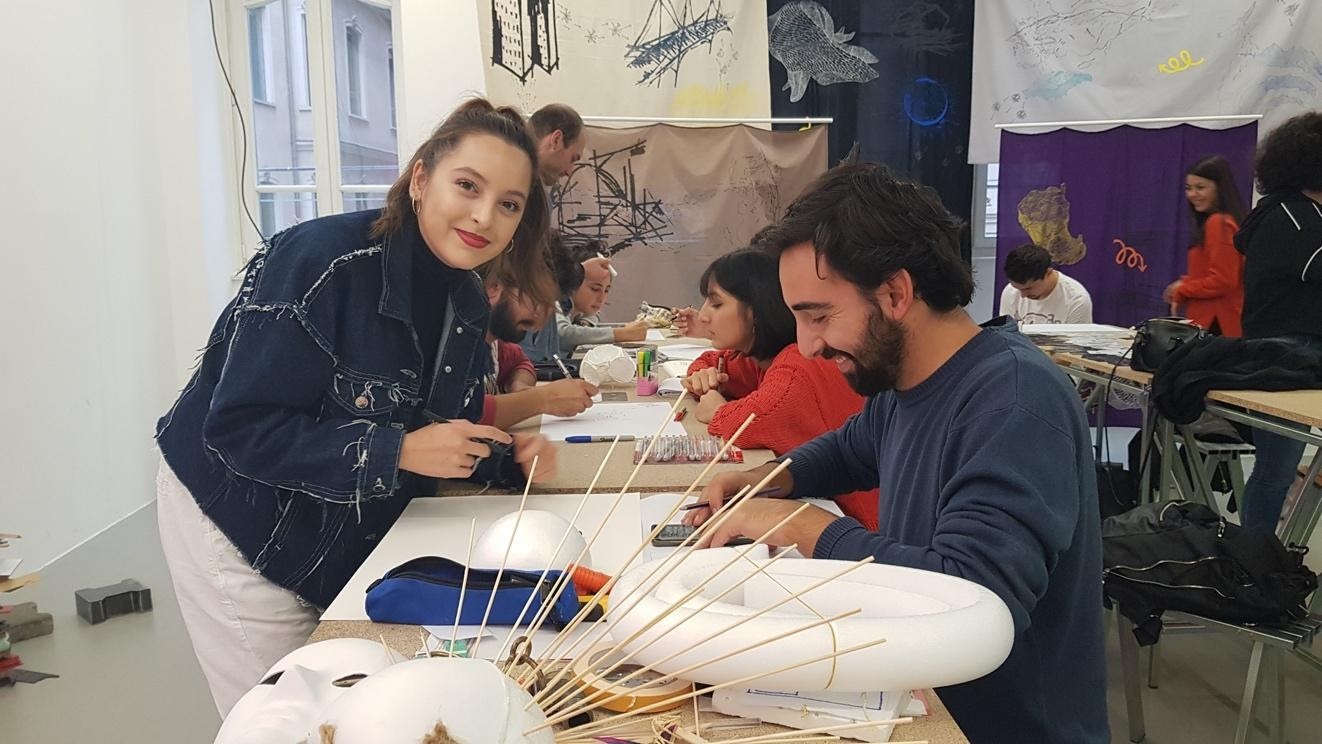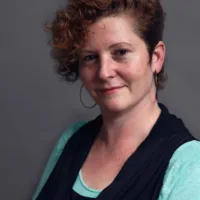In the monthly meetings of this group, participants work with the Design Lector, Alice Twemlow, and in close cooperation with the KABK Workshops to develop a pedagogical tool or toolset for use in the workshop, studio or classroom. In the first phase, participants are invited to define parameters and refine their research question in relation to the existing needs within their department and/or the academy at large. Based on this initial inquiry, participating tutors will develop a prototype to be tested out with students, the results of which will be documented and analysed. The insights gained and the (prototype) tools developed in this process will be available to the wider KABK teaching community.
Participants KABK Teaching Tools Research Group 2020
Overview of the participants and their research projects:
A Research-Atelier Between Architecture and Life
In this research trajectory, I would like to reflect on my previous pedagogical practice at KABK/KC to create a framework for a practice-based ‘research atelier’ that exploits architecture as a creative tool for figuring out ourselves and constructing ourselves differently.
In my PhD trajectory, I have studied the reciprocal relationship between organisms and environment through creative research methodologies to reconsider architectural habit(at)s in which space and time, mind and body, theory and practice have too long been considered distinct abstract notions. Within the context of the ArtScience Interfaculty, I have been developing this into a pedagogical approach that foregrounds tiny perceptions as a design and research tool. I have done this in separate courses that, over the years, have resulted in a body of work currently inaccessible for (new) students and colleagues. This body of work shows the development of a long-term research trajectory with a focus in-between architecture, performance and philosophy and the development of a specific pedagogical approach towards practice-based research in architecture.
I want to take the organizational structure of my earlier work at KABK in the research lab ALEPH as the starting point for this trajectory. I will reflect on the existing body of work and re-formulate the conclusions towards a thematic research framework. The motivating questions that guide this reflection are: How can we set up a research atelier to enable students to join an ongoing long-term research trajectory? How can we introduce new students and colleagues to the body of work, keep education accessible for newcomers and develop new insights every time?
The long-term intention is to develop a research atelier in which students, lecturers, and practitioners can collaborate on research realisations in exhibitions, seminars, mock-ups and build projects that support bachelor, master and doctoral research and open up the opportunity for post-graduate practice-based research.
Image. Exploration of the architectural body. 1:1 research in collaboration with students from the ArtScience
Interfaculty. Image by Cocky Eek. February 2020
Craft Exploded
This research project is based on the assumption that it is beneficial for a student in art and design to acquire haptic material knowledge whilst acquiring theoretical knowledge. The institutional context of art and design education within KABK is still defined by a split between the spaces where theory is taught and the spaces where the fabrication of the projects takes place. These spaces are both physical and intellectual. I want to discover some of the routes by which this divide might be bridged.
The resurgence of popular interest in craftsmanship and crafts, generally referred to as the Maker Movement, might provide fresh ideas to be applied in the curriculum of art education and also for a levelling of priorities, balancing the importance given to theory and material practice, possibly recreating the symbiotic relationship in between the two. My goal is to put together a pool of resources that will eventually lead to a series of research-through-practice projects that will be investigated in the context of the KABK workshops.
What I find essential to consider here are not the exquisite production values that used to define the word 'craft', but the innovative attitude implicit in this practice. There is no purpose or time for an art student to develop the precision involved in manually crafted objects of the past. Technical skills are instead a way of opening new possibilities. What new criteria are needed to assess outcomes when making the first steps into learning a particular technique? What is the role of failure in this process?
Critical Tools
As artists and designers, we often take our tools for granted: drill, brush, screw, camera, laptop, pencil, pen, paper, ink, software, hardware, printer, etc. But where do these tools come from? How were they made? By whom? In what context? Under what historical, social, economic and ecological conditions? I will explore these questions through theoretical texts on new materialism and posthumanism, research in and among the KABK workshops and reflection on my own pedagogic practice.
How can collaboration and exchange between theory and practice courses, between disciplines and between workshops be encouraged to develop other toolsets and networks to confront the complex problems of waste production in art and design? How can theoretical coursework be more closely aligned with material and technical concerns?
This research will be based on the workshops in the academy, seeking to cultivate new relationships with the tools and materials. This time, I will not be ‘using’ the machines to make things, but investigating the critical potential of the working in different ways by collaborating with the tools. For example, in the field of photography, I will explore the conceptual underpinnings of the camera.
In 2018, Ariella Azoulay published a series of essays titled 'Unlearning Decisive Moments of Photography'. She points out how there is an intrinsic link between the colonial gaze and the invention of the photographic camera. The common viewing arrangement of ‘shooting’ and ‘capturing’, taking pictures across the planet to archive, control and analyze is an imperial way of looking at the world and is hard-coded into the camera as a tool. The practice of taking pictures, printing them, putting them on display also generates a tremendous amount of (chemical) waste. Are there other ways of working that are less exploitative? What does this mean for the practice of photography? How to work with this knowledge and develop other ways of working with tools? Is it possible to rub history against the grain and make different pictures that do not reproduce the logic of imperialism, extraction and waste production?
Together with workshop instructors and teachers from different departments, I hope to create a toolkit and set of practices for new ways of teaching transdisciplinary collaboration. Ways that are critical of the affordances and genealogies embedded in the tools. Ways that do not, by default, consume new materials and produce tremendous amounts of waste, offering a decentralization of the maker to a collaborator with a network of tools and technologies. This requires different forms of collaboration between theory and practice teachers, which I would like to initiate throughout the coming year. I hope students will be challenged and invited to a more holistic and hybrid form of teaching that is critical of the tools we use.

Critical Making Workshop at Istanbul Design Biennale 2018, prototyping disobedient technologies
Fingerlings
The raw matter that we have at our disposal defines how we shape our environment and allows us to make sense of it. Unfortunately, in the building industry, design has been reduced to the copy-pasting of surfaces onto structures. Here, the designer hops from concept to cardboard to catalogue, applying products rather than supplying them, dealing with structure and function but not materiality and thus overlooking the potential that material might have for shaping these structures. Unaware of the microstructures in matter that we can influence and form, architects are dismissed as agents in the construction industry.
This project researches how to activate students of Interior Architecture & Furniture Design at KABK to contribute to the design profession by becoming conscious agents in forming matter. Students are invited to experiment with microstructures by producing samples, documenting recipes, making triaxial tests and forming collections in a library. Such an andragogic model defines the creative design process as gathering and sharing material knowledge rather than presenting end-products.
Artists, designers and experts from various material fields are invited to contribute to an archive of finger exercises that help students gain expertise in working with a particular material. This repertoire will form the basis for teaching young designers and artists while cumulatively adding to a larger body of knowledge, which will be available across all KABK departments.
RECURSE: Thinking about and in systems
How can a lens on systems and systems theory be applied as a teaching tool in art and design practices to further collective thinking and making?
This research proposes to forward systems thinking as a critical tool in addressing today's environmental, political, social and economic challenges and as a method to drive artistic experimentation. Furthermore, it aspires to sharpen a systems lens on how we–as a complex learning and teaching system at the KABK–reflect and communicate our shared efforts.
It is based on the hypothesis that talking systems language offers a way to reflect how a designed entity interacts within the world and how we collaborate in the designing of things or the making of artworks. I will use as case studies a set of teaching situations over the last four years where I have used system thinking and system theory as an explicit or implicit teaching tool.
For example, I taught a 4-week workshop in the KABK ArtScience department titled 'Performance Systems: Systems in Action' where we explored the question 'Why is democracy so difficult?' With this project, I aimed to bring ArtScience content to the theatre stage and to explore collective making (and moving) as a tool to research the behaviour of systems. How can actions be generated by setting simple rules and conditions, and how can those rules give rise to collective compositions? How can the body’s physical immediacy, spatial movement, and participation and synchronization within groups form the constituents of a performance system?




